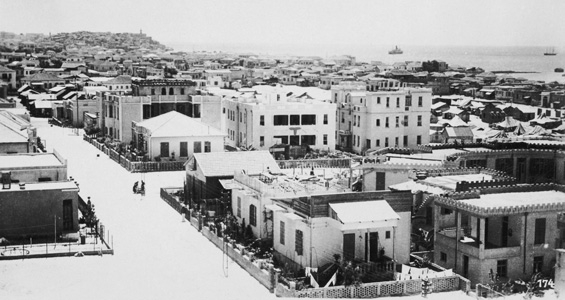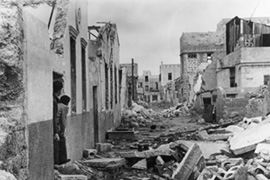Jaffa Citizens, Palestinian and Jewish, protest death of public housing
 Friday, February 22, 2013 at 09:34PM
Friday, February 22, 2013 at 09:34PM By Mya Guarnieri
|Published November 30, 2011]
On 29 November 2011, dozens of citizens of Israel, Palestinian and Jewish, staged a mock funeral for the death of Israel’s public housing, in protest of the evictions that threaten to leave both Palestinian and Jewish families homeless
Protesting the death of public housing in Jaffa (photo: Activestills/Oren Ziv)
The group of Palestinian and Jewish Israeli protesters held the demonstration in front of Halamish offices in Jaffa. Halamish and Amidar are the two companies that manage public housing in Israel. Currently, more than 800 Palestinian and Jewish families face eviction from their homes in Jaffa and impoverished areas of South Tel Aviv. Many of these people are in dire financial straits and have nowhere to go.
By evicting the residents, the companies pave the way for wealthy developers who stand to make a profit by either renovating old buildings or replacing them with new structures. While both Jaffa and South Tel Aviv are undergoing intense processes of gentrification, in Jaffa, the housing struggle has nationalistic undertones and is fraught with racial tension.
In recent years, land in Jaffa has been turned over to Bemuna, a company that constructs Jewish-only housing for religious nationalist Israelis, often in West Bank settlements. Its first project was in the predominantly Palestinian neighborhood of Ajami. And some of Jaffa’s new Jewish residents are former West Bank settlers who have moved into this “mixed” area with the intent of Judaicizing it.
The struggle of Palestinians and low-income Jewish Israelis creates, at times, an uneasy alliance between the two groups. Many of the Jewish Israelis who face eviction from their homes are Mizrachim – Jews from Arab countries – who typically vote for hardline parties like Likud and Shas. But, when they realize that the state privileges the interests of settlers and capitalists over those of low-income Jews, some understand that they have a common cause with Palestinian citizens of the state.
Although this summer’s protests brought Israel’s housing issues to light, both Palestinian citizens of the state and low income Jewish Israelis have been protesting home evictions for years. In 1982, a Mizrachi resident of South Tel Aviv was shot and killed by Israeli police as he tried to defend his property from Israeli forces.
This post was cross-published on the website of the Alternative Information Center.
---------------------------------------------------------------------------------------------------------------------------------
 |
|
Jaffa, now called Yafo by the Israelis, was once the cultural and economic hub of Palestine [GETTY] |
Jewish settlers storming the garden of an elderly Palestinian woman may seem like something you would expect to happen in Hebron, not cosmopolitan Tel Aviv. But that is exactly what happened to Zeinab Rachayel, an Arab resident of Tel Aviv's mixed suburb, Yafo.
Rachayel was in her courtyard on a Sunday afternoon when several buses full of settlers from the West Bank arrived, parking nearby. Armed with Israeli flags, young men lined the sidewalk outside her home chanting "this is our land". One by one, they entered her garden, until Rachayel was confronted by dozens of settlers in their late teens and early twenties.
"Another one entered and he said, 'Listen, you're not staying here. Yafo is just for Jews. Get out of Yafo,'" Rachayel says. The men continued to threaten and intimidate her, repeatedly saying that the Arab presence in Yafo is only temporary.
A cultural hub
Yafo was once Jaffa - the cultural and economic hub of Palestine. Battered during the 1948 Arab-Israeli war, the conflict that surrounded the creation of the Jewish state, Jaffa's population plummeted as residents fled or were expelled from their homes.
Jewish immigrants quickly took their places and in 1950, the Tel Aviv municipality swallowed Jaffa, renaming it Yafo.
Today, some 60 years later, the twin forces of settlers and gentrification means the area's Palestinian community are again facing an existential threat.
On that Sunday afternoon, one of Rachayel's sons arrived. He used his belt, waving the buckle, to chase the settlers out of the garden. Eventually, the police arrived, but no arrests were made.
Rachayel asks: "If this had happened the other way around, to a Jewish family, what would they have done?"
She stresses that, as is the case in other mixed areas of Israel, Jews and Arabs have long enjoyed close relationships in Yafo. Rachayel grew up next to a Jewish family and recalls how the children were like brothers and sisters to her.
But, she says, ties grew tense during the first Intifada. And now, with settlers trickling into Yafo, Rachayel feels the mood darkening again. "It's sad," she tells me.
Going mainstream
Sami Abu Shehadeh, the head of Yafo's Popular Committee Against Home Demolitions, estimates that approximately 50 settler families are scattered throughout Yafo.
They began moving to mixed cities in the wake of Israel's 2005 withdrawal from the Gaza Strip in a bid to make themselves more familiar to Jewish Israelis and to garner mainstream support.
It is also an attempt to stay on the political radar, Abu Shehadeh says.
"If any of the Israeli prime ministers will have the guts to take a settler out of the West Bank, they will set Israel on fire from the inside. It's not that they're going to demonstrate in the settlements. Now they're here, in the heart."
Writing for Haaretz, right-wing journalist Nadav Shragai has aligned the settlements inside mixed cities as a battlefront in the so-called demographic war between Arabs and Jews.
"Israel, as the state of the Jewish people, is losing its grip on these cities," he wrote, adding "settlers in Judea and Samaria have dispatched their best people and rabbis to [Yafo], Acre, Lod and Ramle".
Forcing Arabs out
 |
| The area was battered during the Arab-Israeli war in 1948 [GETTY] |
Bemuna, a construction company whose name means "in faith", aims to bring another 20 such families to Ajami, a predominantly Palestinian area considered the heart of Yafo's fragile Arab community. Bemuna is planning an apartment complex that will be exclusive to national-religious Jews.
"They started in East Jerusalem," Abu Shehadeh says. "Then they had a big project in Lod. Then they went to Akko. Now, they are coming to Yafo."
The move, Bemuna claims, is intended to strengthen the Jewish community. But critics point out that rather than building in one of Yafo's underprivileged Jewish areas, Bemuna purchased land where very few Jews live. The plans to build in Ajami, critics say, are a provocation at best; at worst, it is an attempt to push Arabs from the area.
Abu Shehadeh and other members of the local leadership are concerned with the closed nature of the development. "We felt it is racism, so we went to court."
Tel Aviv District Judge Yehuda Zaft ruled against the petition, which contested the project's discriminatory selection of residents and was filed by over a dozen organisations, including the Association for Civil Rights in Israel (ACRI). The group is appealing the decision and on June 21, the Israeli supreme court will hear the case.
Creating new realities
But no matter what the supreme court rules, Yafo will remain embroiled in problems.
Residents are deeply troubled by a recently opened yeshiva, or Jewish institution for religious studies. Like many found in the West Bank, Yafo's yeshiva is an ideological training ground for national-religious men who intend to join the army. And it is led by Rabbi Eliyahi Mali, who hails from the settlement Bet El.
Speaking to Israeli Channel Seven, Rabbi Mali called his work in Yafo "an important mission like no other," adding that if West Bank settlements "would send one tenth of their residents to large cities ... this one tenth of people imbued with faith will establish a community, a yeshiva, and a centre amidst the Jewish populace, which will create a different reality than we know today".
Abu Shehadeh says: "In their vision, this [Palestinian] neighbourhood does not exist in the next 10 years."
It is a common sentiment amongst Arab residents - the yeshiva is a sign of a takeover, an attempt to turn Yafo into a West Bank settlement.
Palestinian residents report that they have been verbally harassed by yeshiva students. Now, they avoid both the building and the street it is on, out of fear of further altercations.
Ihlas Yateen, a Palestinian resident of Yafo, calls the yeshiva and settlers "dangerous".
"What are they doing here?" she asks.
"I don't know why the state lets them do it. They can't forbid them from entering here? What, they'd let [Arabs] enter Bnei Brak?" she adds, referring to the Orthodox Jewish city near Tel Aviv.
Highest bidders
 |
| The suburb is prime real estate that can be sold to the highest bidder [Mya Guarnieri] |
Her comment points towards gentrification's role in Yafo's problems.
The government-controlled Israel land authority sells to the highest bidder. In the case of the lot slated for the 20-unit settlement that was Bemuna. Money dictates who can buy where.
Yafo's Palestinian residents point out that, for the most part, their community is poor. And Ajami is the weakest link. Perched on a hill close to the sea, Ajami is also prime real estate.
Yehudit Ilani, a Jewish Israeli resident of Ajami and an advocate for Palestinian home and land allocation rights, explains that the Israeli government has strict codes regarding houses in Yafo.
If a growing family adds a room to their home or fails to maintain a building's appearance in accordance with the state's standards, they face astronomical fines, eviction or demolition.
Once a home has been emptied or destroyed, the land authority can sell the plot.
"There are 498 court cases to kick people out of their homes," Ilani explains. Of these, all but one are against Arab families. The only Jewish family facing eviction are an impoverished Mizrahi (Arab Jewish) family.
Ilani says there are other residents facing eviction as the land authority seeks to cash in on a hot market. These families receive some compensation, she explains, "but it's not enough money to get back in the market".
Ilani points out that, as the Palestinian community is "being torn apart," the state can make the choice not to sell the property. "They're hiding behind the market, denying that a nationalist principle is involved," she says.
"Gentrification is being used as a method of ethnic cleansing, in effect."
From sharing to segregation
Ilani says the Jewish Israelis who decide to live in Yafo are not the problem. Rather it is the state policies that are "part of a much larger picture" threatening the area.
This has dangerous implications for the state, Ilani says. "It's a completely segregated society. Only in the shared cities is there some sort of a discourse, a dialogue, knowing each other. The shared cities could be the basis of a way of living together."
But gentrification and settlers are chipping away at this hope, little by little.
Esther Saba is a Palestinian resident of Yafo who faced demolition due to an unauthorised addition to her family home. She points out that when the bulldozers arrived, Jewish Israeli activists paid a pivotal role in saving her home, standing in the front yard and on the roof to guard it.
"There is no problem with regular Jews," Saba says. "We have a very good connection."
But the growing presence of settlers is worrisome, Saba says. "They don't want [Arabs] here in Yafo."
Neither Bemuna nor Yeshivat Yafo responded to multiple requests for comment.
 APJP |
APJP |  Post a Comment |
Post a Comment | 